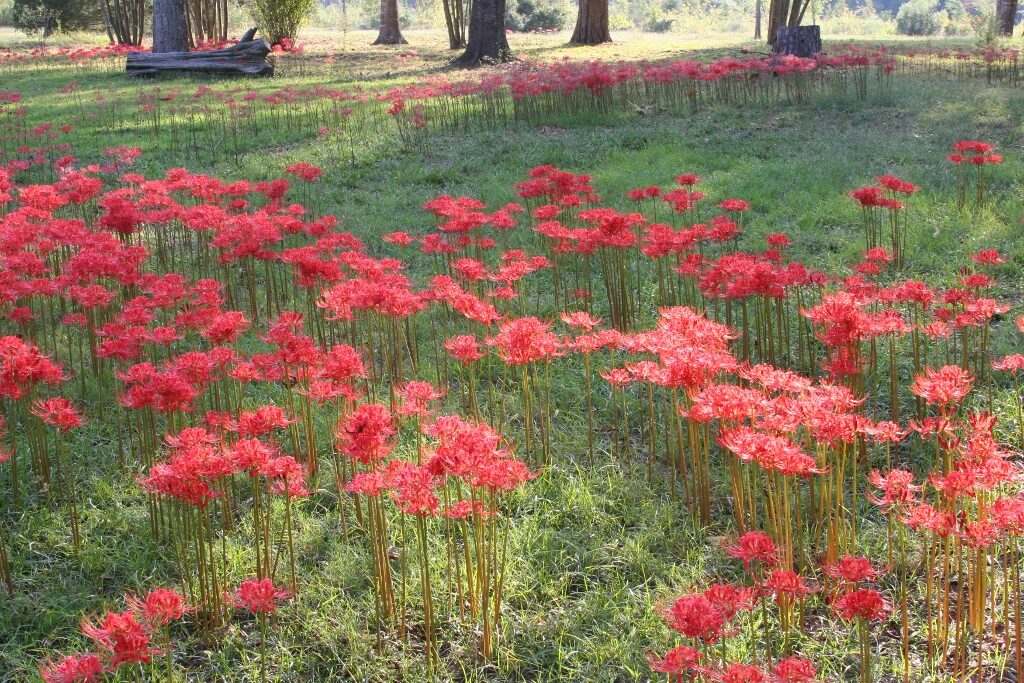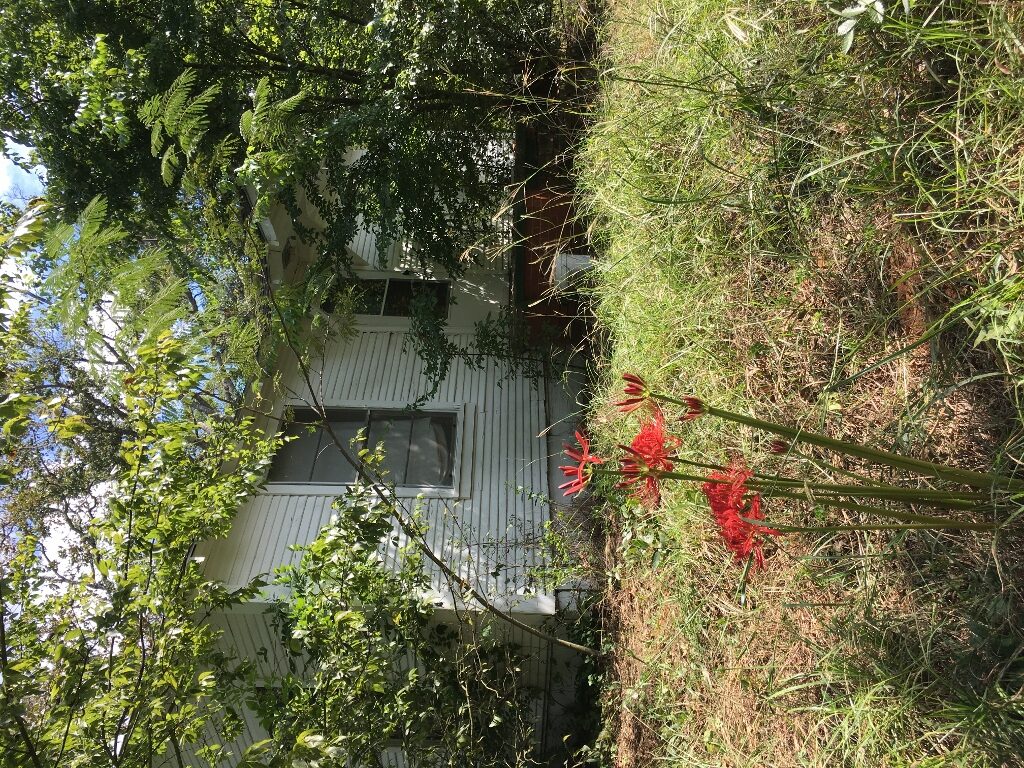Vibrant spider lilies, showcasing natures beauty.

Quite often folks ask about how Lycoris radiata spread — a bulb we commonly call the red spider lily, but also known as hurricane lilies, surprise lilies, British soldiers, etc. It may seem that birds carry the bulb seeds and spread them around, but the Lycoris radiata is a triploid, like a mule. In other words, this naturally occurring hybrid does not produce seed.
So then, how does this bulb spread? Well, for the most part it stays clumped up together. It propagates itself through the asexual process of dividing a clone out of the base of the bulb—a genetically rich area called the basil plate. We call this new bulb a daughter bulb. It is not uncommon to find 20-30 bulbs in a nice “clump.” This clump helps moderate moisture and temperature to allow some, but not all, of the bulbs to bloom reliably. Therefore, we say that red spider lilies bloom irregularly once first transplanted (they can skip a year or two of blooms), but once “established” they bloom more regularly.
But this still leaves a question, how do spider lilies spread? I will take the summary from above and expand:
- Mechanical: you inadvertently spread them yourself. This is usually true of red spider lilies. When you dig up a garden, move plants around, pull weeds, and so on, daughter spider lily bulbs can be small enough (although not tiny) to be hidden in the dirt. The wheelbarrow can tip over along a route, or the bulb can be hidden in weeds casually thrown out in the lawn. Bulbs are tough and there is a lot of food stored in that bulb. When the conditions are right, and long after you forgot you had thrown a clump of dirt somewhere, that bulb begins to grow. If the location of the thrown dirt is in the lawn, you might not see it for years as the foliage is regularly mown in the lawn. Usually, it is not until one cold winter when the grass is greyish and dormant, that you spot a thriving green spot of foliage growing in your lawn. Upon closer inspection, you realize some bulbs (or monkey grass most commonly!) ended up there.
- Squirrels, Armadillos, etc. Even though varmints will not eat red spider lilies, they still move them around, especially if they are freshly planted in moist lose dirt. Once the bulbs are clumped up and firmly in the ground, varmints will generally leave them alone. Hogs are a whole different topic. Tasty bulbs like tulips, hyacinths, and lilies can be picked up by voles and carried through their tunnel system, but edible bulbs is also another topic.
- They were there already. Was the previous owner of your house a master gardener, or a lover of gardening who passed along plants with neighbors down the road? The bulbs could have been in the garden from this previous gardener and this something you might not have even realized. Who knows why the bulbs were “out of sight, out of mind” for so long? Maybe a storm knocked down a tree and the bulbs are now thriving in new-found light? Maybe a busted water line caused a contractor to move dirt from one spot to another? Now these bulbs are receiving the light and moisture they need to thrive, and they finally bloomed for the first time in 20 years. It might seem like a critter moved them around, but they were there all along.
- Possibly seed (but not for triploid flower bulbs which includes the red spider lily). Most bulbs on the market that we plant are actually triploid mules, meaning they are sterile and don’t produce seed. Some bulbs will produce seed though, like the Philippine (Formosa) lilies or some pink rain lilies (Habranthus robustus). These can get blown around by the wind or moved by critters and will end up in the craziest places in your garden.
- They did it themselves. Some bulbs, like tulips, are stoloniferous and will send out runners. They are not aggressive like bamboo, but they will indeed spread. They will usually stay contained in a small geographic area (i.e. naturalize).

So, there is a brief top 5 list on how flower bulbs spread in the garden. If you WANT bulbs to spread and naturalize, there are ways to ensure this occurs, but that is also another topic. Just remember, most ornamental flower bulbs want plenty of light—that is the first hint and we can talk more about that in the future.
Have more questions, feel free to send follow up e-mails to info@southernbulbs.com or call us at 888-285-2486. Check out more information at www.southernbulbs.com

Great article. Thanks for the information and Happy New Year. Meeting you was a highlight in my 2020.
Very kind! It was a fun spring and hopefully we meet again in the future!!
When is the best time to dig up spider lily bulbs to share with others?
Thank you.
P. Baker
Good question! The absolute best time is right after the foliage has died down in the early summer. A parallel answer would be that the best time to share them is when you have an opportunity–the bulbs might take a year or two to get back in sync if moved at different times of year, but they are tough and will recover!
How can I purchase tulip bulbs that grow in Texas??
Hi Carol,
We normally have a selection in the fall. We currently have one selection left but it would need to be planted in the next couple of weeks (https://www.southernbulbs.com/tulipa-bakeri-lilac-wonder/). Tulips in Texas do best in clay and rocky soils that dry out in the summer. These are smaller tulips, not the large Darwin hybrids that we often see in parks or formal settings. Hope that helps!
What are the “large green ‘balls’, on the long stems – just under the beautiful white Texas White Spider Lillies? (The green ‘balls’ are just under where the pretty flowers were – after flowers die, on tall thick stalk)
Hi Jackie! You are referring to the native white spider lilies, Hymenocallis liriosme I believe. Yes, they just wrapped up blooming in April, and those “large green balls” are the seed pods that are ripening. You can scratch those into moist soil, and they should germinate for you, put out roots, and eventually turn into a new bulb. It is the best and easiest way to propagate and grow those bulbs, as digging them in swampy conditions is often laborious and difficult.
A related question: If you planted these bulbs in staggered fashion, will they sync in subsequent years?
I always chuckle when I read about staggered plantings of glad bulbs. Yes, you get different staggered blooms the initial year but the following year(s) they ALL bloom together.
Wondering g if all bulbs eventually “sync”.
I’m sorry we missed this comment. Yes, all flower bulbs for the garden seem to eventually “sink” to a certain blooming time. That is not to say, however, that even in your localized area, bulbs that receive more sun/less sun, more moisture/less moisture, or whatever the condition may be, can cause some clumps to bloom a little earlier or later. These blooms all happen close to a respective time period though. Many of our bulbs, like the schoolhouse lily, move up or down in the soil depending on where they are most happy with moisture and temperature levels.